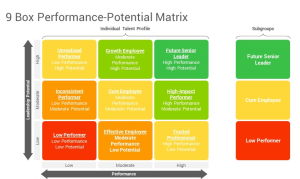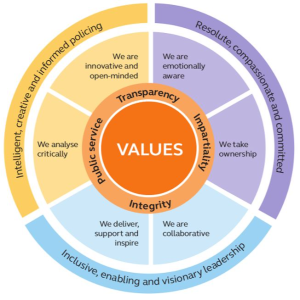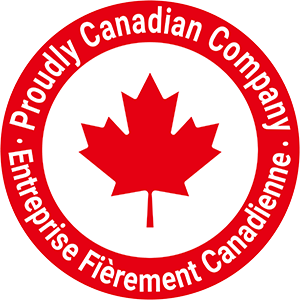Optimizing 9-Box and The Leadership Competency Model
By Ian Fratarcangeli |
5.5 min read
The 9-box model is a widely used performance and potential matrix that is an incredibly helpful tool for succession planning and development. Although the tool has been available to the public for a long time, there are few who truly understand the intricacies of the mechanism and how valuable it can be when planning and developing a leadership team.
Simple & Effective
The 9-box model is powerful because of its simplicity and effectiveness. The model is composed of 9 boxes arranged on a grid, with performance measured along the x-axis, and potential measured along the y-axis. The most valuable position is the top right box, which is composed of those ranking high in both performance and potential. Conversely, the bottom left box is the place for those ranking low in both categories.
This illustration is a catalyst for constructive dialogue and in turn, will facilitate discussion, teamwork, and development. The idea behind the matrix is that by identifying how each employee fits into the grid, you can better understand where each employee stands and how they should be positioned in future organizational shifts. However, from the experience of Predictive Success CEO David Lahey, the model may run into trouble if communication is not transparent.

For all 9-box models, a leadership competency model must be created. These models are made to highlight the leadership skills and behaviors that contribute to peak performance. When succession planning, a competency-based approach can help organizations decide best fit for their future leaders.

Addressing the Problem of Potential
Now it is easy to recognize the past performance of individual employees, but identifying their potential is a complicated task. A common difficulty experienced by users of the 9-box model is to accurately position their candidates onto the matrix, as well as determining an execution strategy for their succession plan. In addition, after the creation of a leadership competency model, identifying who fits best into their most competent leader pattern is often not done effectively.
Fortunately, there are tools available to help with these shortfalls. The Predictive Index (PI) has a vast product offering to assist in the implementation of the 9-box and leadership competency model, as well as formulating succession planning strategies. Predictive Index has been providing behavioral analytics software for over 60 years and has undergone consistent scientific studies to ensure the validity of their products. This has led PI to become a staple in the hiring and managing infrastructure of organizations worldwide. Below are some tools that are being used to complement these two models to ensure effective and accurate use.
The Predictive Index Behavioral Assessment™ is a free choice, stimulus response survey used to capture the behavioural drives and needs of the user. From this information, management can determine useful information to help determine job fit, management & communication strategies, onboarding plans, and much more. Regarding the 9-box model, the results of the PI assessment can be analyzed and interpreted to better understand the potential of each individual with respect to the job, resulting in a more accurate positioning on the matrix.
PI research states that cognitive ability explains ~26% of job performance. With that being said, the cognitive ability of a candidate is an important factor in determining an employee’s/candidate’s efficiency in grasping new information. The Predictive Index Cognitive Assessment™ is an assessment tool used to establish an accurate reading of the user’s cognitive agility. This tool, in combination with the Behavioral Assessment, would provide an accurate view of someone’s potential. These along with the candidate’s/current employee’s experience will lead to an accurate positioning on the 9-box Matrix.
LTP (Leadership Transition Program)
Once you can accurately determine where an employee fits into the 9-box matrix, strategies must be utilized to help guide your employee towards overall improvement, and heightened leadership responsibilities. The leadership competency model is a useful tool to develop self-awareness in leadership traits for employees. Striving to create stronger leadership should be a goal of any group, and the Leadership Transition Program is formulated to help with just that. The 4-day workshop aims to provide strategies and ideas to help in the transition of employees and current leaders towards expanded leadership roles, which will aid in the efficiency of both the individual and the group.
Team Discovery
Combining people into a team also means putting together their different behaviours and 9-box positions. Variations in how people think and perform may lead to lost potential, which is an issue that team discovery can help solve. Provided in the design module, PI’s innovating team discovery software dives into the intricacies of a team and how they can optimize their performance as a group. Team discovery serves as tool after the 9-box matrix has been correctly completed. The tool establishes a style of work for the team in the form of a team type, producing their strengths and possible downfalls. Along with their team type, team discover also issues a team strategy type in accordance with the objectives of the group. Both the insights and the recommendations contributed by team discovery enables teams to reach their full potential and increase their efficiency. The benefits of the tool not only apply to the members of the team, but also the leader who develops a better understanding of each team members behaviours and how to manage them properly.
Organizational Chart
This feature is a valuable succession planning tool, as it illustrates the current organizational depth chart along with each employee’s behavioral assessment. The chart provides a concrete picture that can be drawn upon to determine why employees are thriving or lagging in their current roles, and which may be best suited for promotional opportunities.
In short, the 9-box model is an effective tool in the succession planning process, however analytics software can help tremendously to obtain the most value from the matrix. Using PI’s behavioral and cognitive assessments, one can accurately position an individual on the matrix. Using the leadership competency model, you can easily identify areas that the organization or group can rely on to continually further their leadership capabilities. With the Leadership Transition Program and PI organizational charts, establishing development strategies and an effective succession plan becomes a simple and definitive process that will lead to a future of formidable leadership.
Click here to try PI and learn more about what it can do for you.
Original Creator: Thomas MacIntosh
Updated by: Ian Fratarcangeli
Related Blogs
Layoffs vs. Furloughs: What’s the Difference and Which Is Better for Employers?
Layoffs vs. Furloughs: What's the Difference and Which Is Better for Employers? Economic uncertainty, market shifts, and rapid organizational change force leaders to make difficult workforce decisions. One of the most common challenges leaders face
5 Types of Communication Styles and How to Use Them Effectively
The 5 Communication Styles and How to Use Them Effectively Communication is the foundation of every successful business interaction, whether you are leading a strategic planning session, managing change, coaching a team member, or sharing
Average Typing Speed (WPM): What’s Good, What’s Fast and How to Improve
Average Typing Speed (WPM): What’s Good, What’s Fast, and How to Improve Whether you’re a student, professional, or casual computer user, typing efficiently can save you countless hours each year. But how do you know



